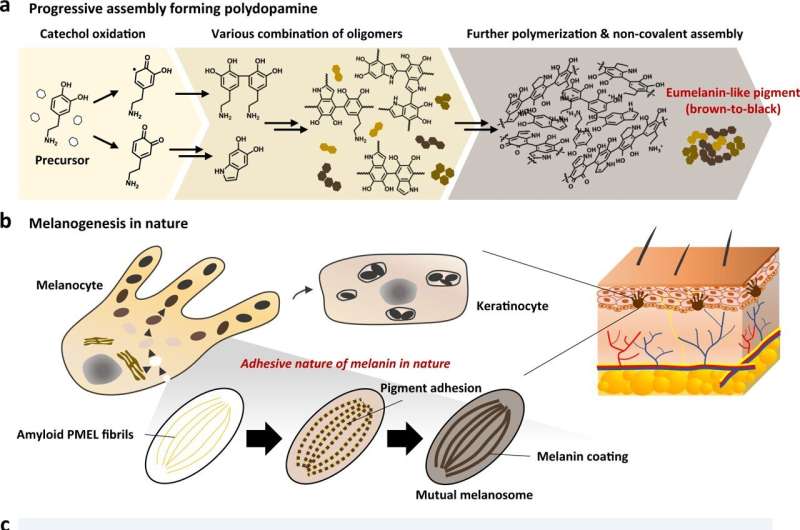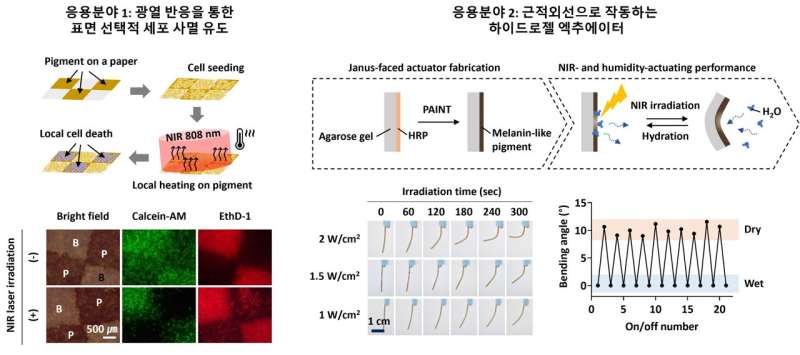This article has been reviewed according to Science X's editorial process and policies. Editors have highlighted the following attributes while ensuring the content's credibility:
fact-checked
peer-reviewed publication
proofread
Scientists copy melanin formation processes to fabricate multi-functional organic pigments

The research team of Seon-ki Hong, Professor at the Department of Physics and Chemistry of Daegu Gyeongbuk Institute of Science and Technology (DGIST), has developed the Progressive Assembly on an Initiator-loaded Template (PAINT) technology that can locally fabricate multi-functional organic pigments at desired areas by copying natural melanin formation processes.
Melanin, a natural pigment, can adhere to various surfaces, regardless of type, thanks to its high underwater adhesive properties that are attributed to numerous catechol functional groups, similar to the adhesive proteins in mussels. New multi-functional organic materials copying these unique properties have been recently developed and widely applied in various fields.
However, during the process of creating new elements by integrating new organic materials with various material groups, researchers faced challenges when unintended areas became coated with organic matter due to the adhesive properties that are the unique advantage of these new organic materials.
To overcome these challenges, researchers used photolithography to specify the coating location. However, this method has drawbacks, such as the involvement of complex multi-step reactions and the need to use expensive equipment.
To solve these issues, Professor Hong's research team investigated the formation processes of natural melanin, and found that the catalytic activity of the protein template significantly affects the process of specifying the pattern formation location. The findings are published in the journal Nature Communications.
Based on the analytic results, the team conducted an experiment on the synthesis reaction of organic pigments copying the natural melanin formation process. Organic pigments were produced by initiating the synthesis reaction on the surface that was initially modified to have localized catalytic activity.

The research team confirmed that organic pigments had not spread to neighboring regions based on excellent adhesive properties, and that they adhered selectively and voluntarily only to the initiated areas to form patterns.
Organic pigment patterns locally formed on the surface exhibited broad optical absorption characteristics in the ultraviolet, visible, and near-infrared spectral regions, similar to natural melanin. The absorbed near-infrared light was spontaneously converted into thermal energy by the material and generated localized heat. The research team verified that these processes can be applied to induce selective cell death on the surface, or to drive actuators.
Prof. Hong stated, "The PAINT technology that we developed in this research is a novel technology that can selectively apply materials with universal adhesive properties to only desired areas."
She added, "We anticipate that the PAINT technology will establish the foundation for the development of new melanin-like organic materials applying the characteristics of melanin, such as excellent optical absorption, activity of scavenging reactive oxygen species, and biocompatibility."
More information: Haejin Jeong et al, Site-specific fabrication of a melanin-like pigment through spatially confined progressive assembly on an initiator-loaded template, Nature Communications (2023). DOI: 10.1038/s41467-023-38622-2
Journal information: Nature Communications
Provided by Daegu Gyeongbuk Institute of Science and Technology





















